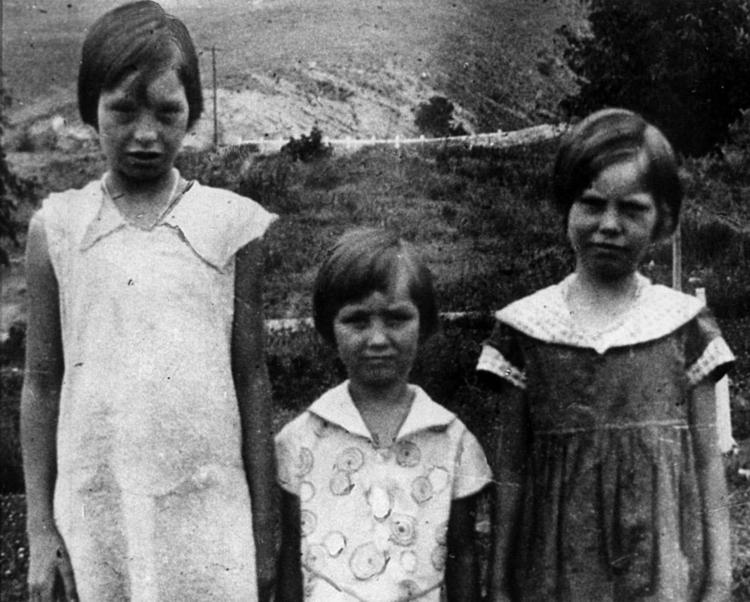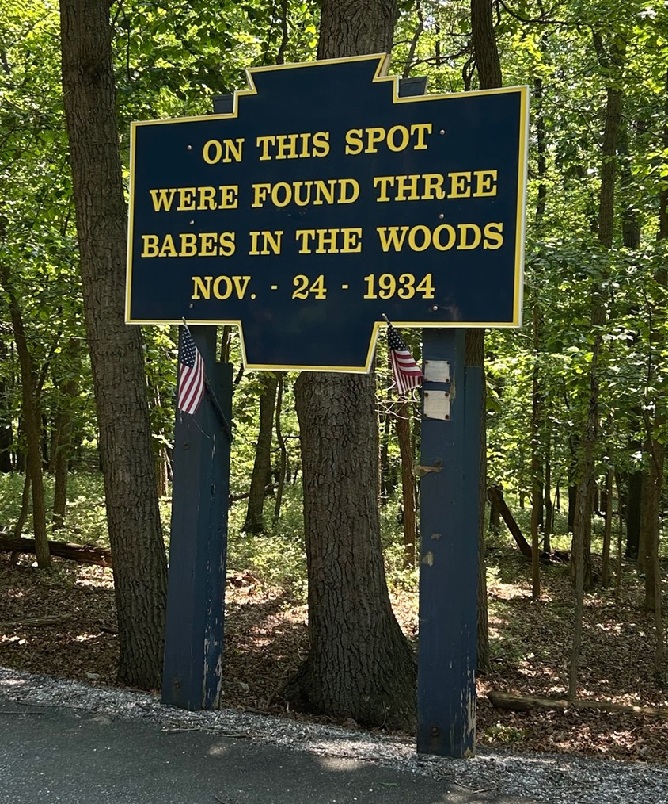This horrendous crime and its investigation were of great local and national interest at the time. We include it here because it has a direct connection with the Cameron-Masland Mansion — the bodies of the three girls were discovered by two Cameron mansion employees a few miles from the mansion.
The following story is from Profiles from The Susquehanna Valley, written by Mr. Paul Beers and published by Stackpole Company. It can be found at the Cumberland County Historical Society.

ON November 24, 1934, a Saturday, two caretakers on the James Cameron Estate on South Mountain near Pine Grove Furnace, south of Carlisle, discovered the bodies of three young girls. It was the Babes in the Woods mystery. The girls appeared to be sisters, and a professor at Dickinson College proved that they were by matching strands of hair.
The homicides touched off a national search. “We’ll find out what killed these little girls even if the tax rate in this county has to be raised,” said Cumberland County District Attorney Fred J. Templeton. Eventually, 28 states were in on the investigation, and the Babes in the Woods mystery was front page news for more than a week in the nation’s largest newspapers.
The murdered girls were found on a blanket about 20 feet from the Pinchot Road, which goes through Michaux State Forest at Pine Grove Furnace. The oldest girl was between 12 and 16, the second, between 9 and 11, and the youngest, between 5 and 3. The three were found with the youngest cuddled in the arms of the oldest and the other lying near the side of the oldest. They were clad in new coats with fur collars, dresses of good quality, silk underwear, and even new shoes. Later it was determined that the girls were dressed after they were slain.
All three had light brown hair, freckles, and gray eyes. It had rained the Friday before, but neither the girls nor the blanket was wet. Found nearby was a black leather Gladstone suitcase, containing, among other things, a women’s size 18 dress, a doll with a broken arm, and a tube of toothpaste one-third used.
The Cumberland County Coroner, Dr. Edward S. Haegele of Mechanicsburg, immediately took charge and worked all night on the case. It was quickly determined that the girls had been dead 42 to 72 hours before they were found and that they had nothing to eat 18 hours prior to their slaying. It appeared that a car had parked about 60 feet away and the slain girls were carried one by one to the spot. Dr. George R. Moffitt, Sr., of the Harrisburg Hospital established that the girls did not die of carbon monoxide poisoning. He concluded they were put to death by strangulation or suffocation perhaps by what he called a Japanese wide-band method which left no scars on the neck.
Dr. Vance McCormick Rothrock, of Carlisle, found a dime-sized scar underneath the skin of the forehead of the oldest girl, and he said she had been knocked unconscious before she was murdered. There were no other signs of physical abuse.
Right after the newspapers broke the story of the discovery of the girls, a murder-suicide took place in Duncansville, eight miles from Altoona. A man with no money registered in a lodging, tried to pawn his eyeglasses for $1, gave a nonexistent address in Philadelphia, and then shot his alleged wife and himself. They were listed as Mr. and Mrs. J. C. Gardners.
A Philadelphian said Gardner was really Horace Hughes, 37, of San Francisco, once a Salvation Army officer. The woman was 21 and his intended wife. The children were his own, Geraldine, 15; Dorothy 12; and the youngest, whatever her name, eight. A Harrisburg bus driver said he had the family in his bus. The youngest girl’s name was Jennie, he said. Shortly afterward, an abandoned 1929 blue Pontiac with California tags was found in McVeytown. Tourist cabin and rooming house operators in Langhorne, Gettysburg, Waynesboro, and Chambersburg made identifications. One said that a Mr. and Mrs. J. C. Malone, of Vallejo, California, checked In, telling him that they had left Vallejo on November 6 after voting for Upton Sinclair for governor. The interesting initials of “J.C.”, popped up more than once.
The names of hundreds of lost little girls were sent to Cumberland County and the State Police from all over the nation. At first it was believed that the victims might be a woman and her daughters from Boston, but they were located at Portage, Pa.
Finally, after four days, the deceased man was identified as Elmo J. Noakes, 32, a widower of Roseville, California, and a former Marine who had a steady job and was well respected in his hometown. The woman was his niece and housekeeper, Winifred Pierce, 18. Pictures of the children were sent to an aunt, and they were identified as Noakes’; Norma, 12; Dewella, 10; and Cordelia, 8. Dorothy Tompson and other top reporters got the story and then hurried to Flemington, New Jersey, where the Lindbergh baby murder trial was taking place.
On December 1 in the Westminister Cemetery near Carlisle, 500 persons gathered in the rain for the burial of the children. American Legion Post 101, the cemetery, and the undertaker paid the costs. A monument was erected, with the inscription: “Sleep tender blossoms, folded so close/ In slumber which broken shall be/ By His gentle voice whispering low/ “Little Children Come Unto Me.” Three clergymen conducted the service. A few days later, Noakes and Miss Pierce were buried nearby.
Commissioner Lynn G. Adams of the State Police said the case was closed on December 29. He remarked that Noakes must have been mentally ill to cross the country in seven days and murder his children for no apparent reason. A motive is still lacking for the Babes in the Woods case.

